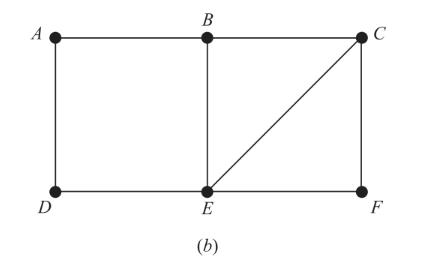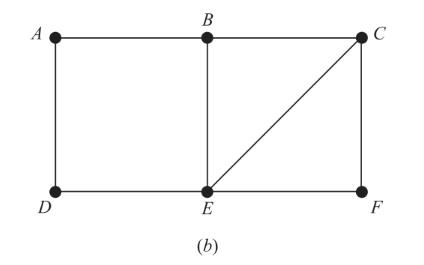1. Let Kn be the complete graph on n vertices and Km,n be the complete bipartite graph on m and n vertices. Find the number of vertices of each graph.
| | A. | 9 | | B. | 14 | | C. | 5 | | D. | None of these | | E. | 6 | | F. | 7 | | G. | 12 |
|
2. Let Kn be the complete graph on n vertices and Km,n be the complete bipartite graph on m and n vertices. Find the number of edges of each graph.
| | A. | 9 | | B. | 20 | | C. | 6 | | D. | 10 | | E. | None of these | | F. | 10 | | G. | 5 |
|
3. A cycle is a closed path in which no vertex is repeated except the first and last. Using the graph G in Fig8-36(b), p.178, find the number of cycles through the vertex

| | A. | 4 | | B. | 5 | | C. | 2 | | D. | 7 | | E. | None of these | | F. | 3 | | G. | 6 |
|
4. A simple path from a vertex x to a vertex y is a path from x to y such that no vertex and hence no edge, is repeated. For the graph G in Fig 8-36(b), p.178, find the number of simple paths

| - | from A to F | | - | from F to A | | - | from B to C | | - | from C to D |
| | A. | 5 | | B. | 3 | | C. | 4 | | D. | None of these | | E. | 6 | | F. | 8 | | G. | 7 |
|
5. A planar graph G = (V, E) has V = {1,2,3,4,5,6} and E = {{1,2},{1,3},{1,4},{1,5},{1,6},{2,3},{3,4},{4,5},{5,6},{6,2}}. Find
| - | the number of regions (faces) | | - | the number of edges | | - | the diameter of G | | - | sum of degrees of vertices |
| | A. | 18 | | B. | 10 | | C. | 6 | | D. | 20 | | E. | 2 | | F. | 15 | | G. | None of these |
|








